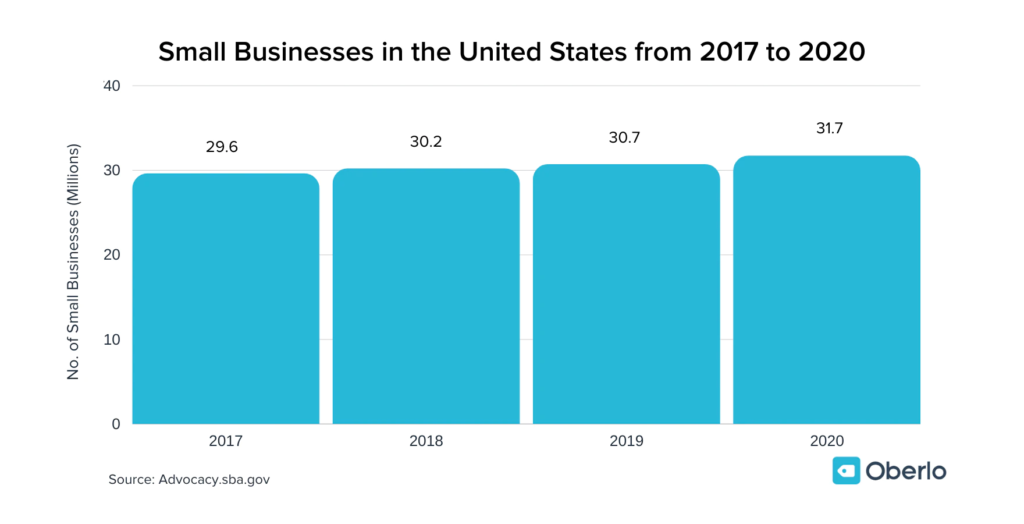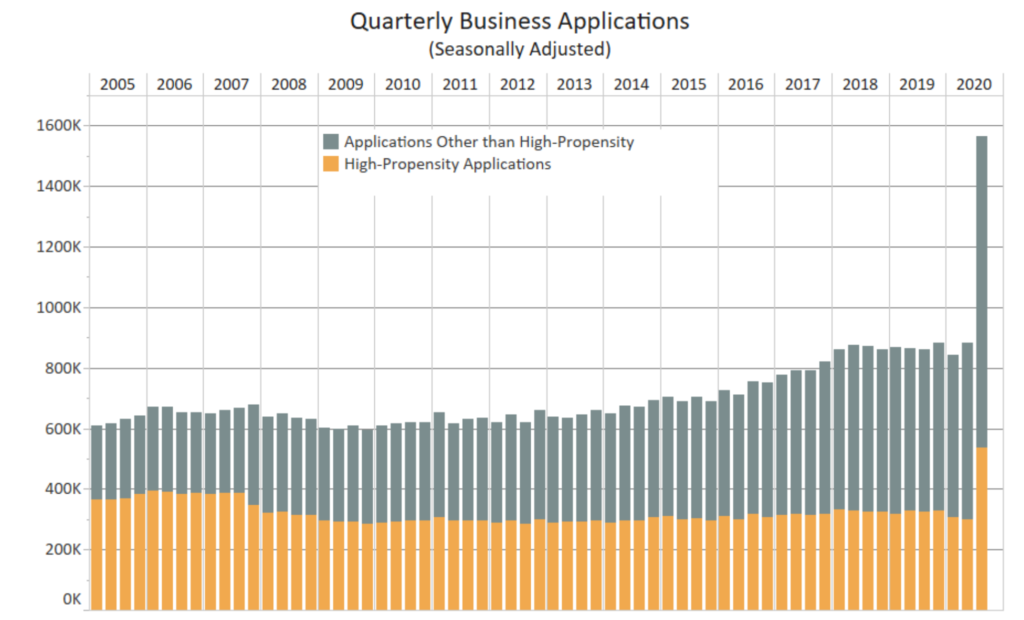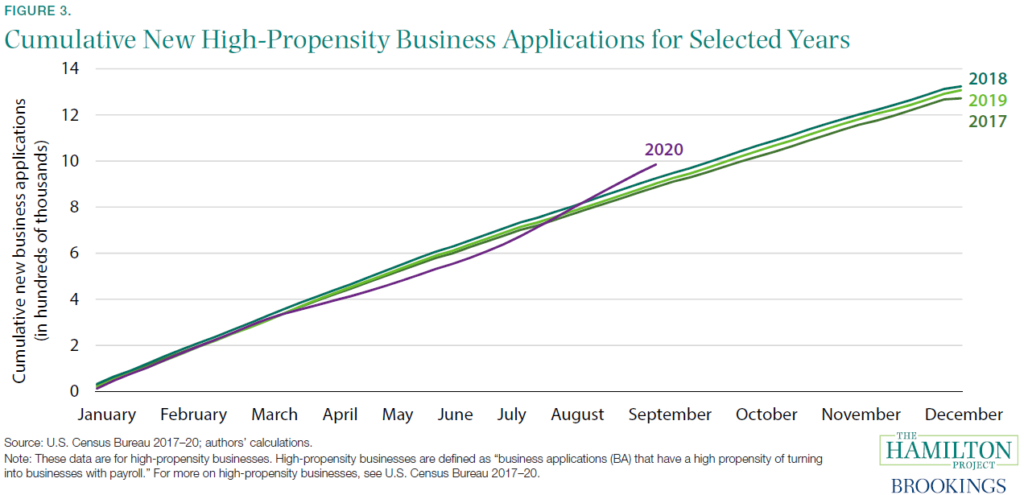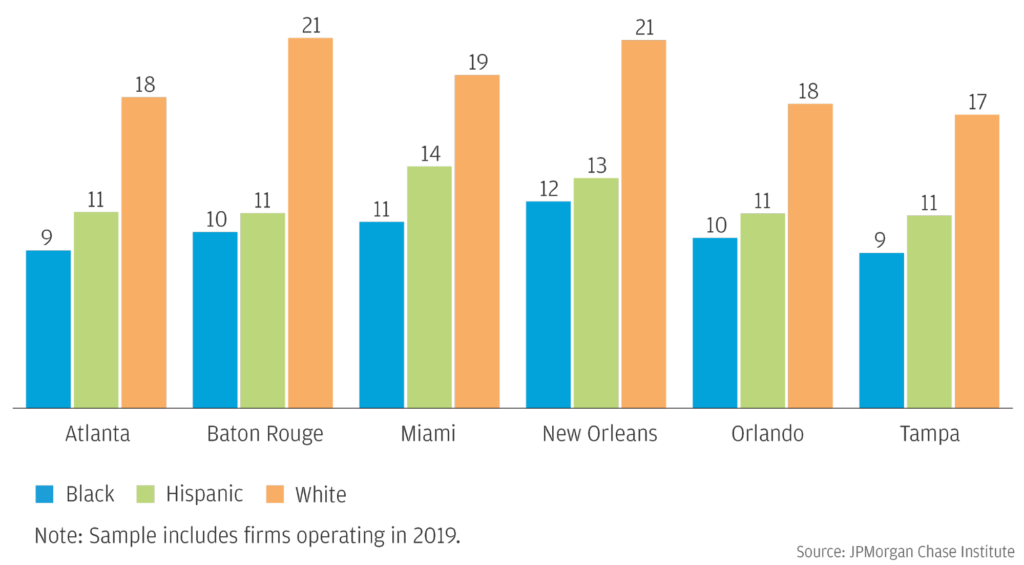Starting a small business can be a great way to make money doing something you love.
It can also be a very intimidating experience, to say the least. It certainly doesn’t help that every day we read new headlines about how small businesses are closing due to the economy, the global pandemic, or just regular consumer trends.
Luckily, the vast majority of that noise is BS. In fact, not only is it possible for your small business to thrive, there is a fairly straightforward path to success so long as you have the right systems and the right information.
That’s why we want to help.
We’ve created this comprehensive study of the key small business facts and statistics you need to know. The information here will give you context and insights into what it’s really like to start a small business this year.
Later, we’ll even give you a few resources to help you start a successful business—even if you don’t have an idea yet.
Our Small Business Facts and Information
- What is a “small business” anyway?
- SMB Growth Statistics and Facts
- SMB and COVID-19 Statistics and Facts
- SMB Demographic Statistics and Facts
- SMB Marketing Statistics and Facts
- Resources for small businesses
What is a “small business” anyway?
Before we jump in, it’s worthwhile to define what a small business actually is.
The Small Business Administration (the US government agency that supports small businesses), defines one as:
“Most manufacturing companies with 500 employees or fewer, and most non-manufacturing businesses with average annual receipts under $7.5 million, will qualify as a small business.”
Though we’re primarily going to be looking at U.S. businesses in this article, we’re going to jump around occasionally and take a look into small businesses in other countries as well.
The definition of a small business changes depending on where you are in the world.
In Canada, a small business is a firm with “fewer than 100 employees.” But the European Union defines small businesses as “enterprises which employ fewer than 250 persons and which have an annual turnover not exceeding EUR 50 million, and/or an annual balance sheet total not exceeding EUR 43 million.”
In China, small businesses are defined as an enterprise with 300 employees or less, and also makes less than 30 million yuan a year.
As you can see, there’s no hard and set definition for what a “small business” is across the world…but we’ll be sticking with the USA definition because that’s where we’re personally based. So, apologies to our international readers out there. But we’ll still jump into some small business facts and statistics that we believe you’ll find very handy.
With that out of the way…
Small Business Growth Statistics and Facts
Small businesses make up the vast majority of all American and European businesses.
- There were around 31.7 million small businesses at the start of 2020.
- This represents a 3.15% increase from the previous year.
- This accounted for 99.9% of all businesses in the United States.
- There were more than 60.6 million small businesses employees in 2019. That accounted for more than 47.1% of all employees in the United States.
- Across the pond, the numbers are comparatively similar. In the UK, there are 5.9 million businesses. Small to medium sized businesses account for 99% of all those businesses.
- Of course, this was all before COVID-19 hit and threw a wrench in small business growth (but we’ll jump into that later).

Small businesses tend to struggle in the first few years of existence.
- About two-thirds of small businesses with employees survive just two years.
- About 50% of small businesses survive at least five years.
- That might seem disheartening and scary for new business owners. However, there’s good news: Once a business gets through the first few years, they have a much better chance of surviving for the long run. The chances of a small business closing go down the longer they are in existence.

Most small businesses are sole proprietors (and are operated from home).
- About 50% of small businesses are considered “home-based businesses”—meaning they’re run out of someone’s personal residence.
- 60.1% of small businesses with no employees are home-based.
- About 86.4% of small businesses that don’t employ workers are sole proprietorships.
- 48.1% of small employer businesses (less than 50 employees) are S-corps. 26% are C-corps.
- C-corps are mostly large employers, with 82.1% of them having 50 employees or more.
Small Business and COVID-19 Statistics and Facts
The global pandemic decimated businesses across the globe, both large and small.
- When lockdown measures began in spring 2020, 140,104 businesses were marked “temporarily closed” by Yelp.com. By fall 2020, 60% of those businesses permanently closed. That’s nearly 98,000 businesses destroyed by the global pandemic (see chart below).

- The United States saw a 20% decrease in new business applications in the spring 2020 when lockdown measures were just kicking off.
- United States saw a 31% reduction in business applications. But the western region saw just 15% in reduction.
- This is the biggest drop in business applications since the Great Recession of 2008-2009.
Business applications dropped differently in various areas of the country. The northeastern

Small business revenue dropped off a cliff (among other things).
- Small business year-over-year revenue fell by 52% in the second quarter of 2020.
- Payroll fared even worse for small businesses, suffering a 54% drop in Q2.
- Revenue for LLCs declined 90%.
- LLCs also saw a 62% drop in employees, as well as a 51% drop in payroll.
- The restaurant industry suffered some of the worst damage due to the pandemic. The average revenue drop for restaurants was 72%.
- In a surprising and cruel twist of the knife, they even saw the number of online and takeout orders drop 38%.
- The average cost of recovery for small businesses is $21,553. This includes things like PPE, as well as renovations related to new COVID-19 safety standards.
- Recovery costs are higher for restaurants who have to pay $52,106 on average for PPE. That’s 78% more for PPE than your average business.
Minority-owned businesses suffered the most.
- The Bank of New York reported that the number of Black small business owners fell 41% in spring 2020. That’s about 440,000 Black business owners.
- White small business owners saw a 17% drop.
- That means Black small business owners suffered at over twice the rate as their white counterparts.
- Meanwhile, Latinx small-business owners saw their businesses drop by 32%.
- Asian-Americans saw a drop of 26%.
- Immigrant small business owners as a whole saw “substantial losses of 36%.”
- Female-owned businesses also suffered a disproportionate loss of 25% compared to 20% for male-owned businesses.

Things are looking up (kind of).
- By Q3, the United States saw more business applications than it had in the previous 15 years.
- Almost 1,600,000 businesses had been applied for since the beginning of 2020.

- The United States saw a massive increase in business applications by a jump of 38.5% in October 2020.

- That means despite the drop in business applications in the spring, 2020 is on track to be one of the highest years on record for business applications.

- By July 2020, 86% of small businesses said they had either partially or completely reopened.
- 55% of small businesses report to be in “good health.”
- The third quarter of 2020 was a boon for the world’s economies. America’s GDP rose by 7.4% (annualized rate of 33%) compared to the previous quarter.
- The “Euro area” saw 12.7% growth when compared to the previous quarter.
- That said, lockdown measures slated for Q4 2020 have people fearful about their long-term prospects. In fact, the economic index for locations locked down since late October 2020 indicates that drop could be as bad as it was in springtime. For example, activity in Cardiff, Wales—where lock down measures began on Oct 23—found that economic activity dropped by 20%.
Small Business Demographic Statistics and Facts
Note: The vast majority of studies and statistics gathered about small businesses subscribe to the gender binary. As such, some of the stats and facts that we’ve gathered below could potentially be misleading (e.g. men versus women business owners).
However, we’ll also include information regarding LGBT+ business owners to hopefully give a fuller picture that better reflects the diverse array of business owners out there.
Most small business owners are men—but that’s changing.
- In the United States, 54% of small business owners are men, while 45% of business owners are women.

- However, there is slow and consistent growth in the number of women small business owners year over year. In fact, the number of women small business owners increased by 5% in three years.
- Women also make up 52% of all sole proprietors.
- Compare this to back in 1972, when women owned just 4.6% of all US businesses.
- Women-owned businesses generate $1.9 trillion annually.
- Women of color make up 50% of all female small business owners.
- Women in the United States are 40% more likely to open a small business than their counterparts in Great Britain.
Most small business owners are Gen Xers—but Millennials are catching up.
- Compared to Millennials, Boomers, and the Silent Generation, Gen-Xers run more small businesses, with 44% of small businesses helmed by the MTV-watching, Joy Division-listening, mixtape-making bunch.
- They are followed at a close second by Boomers with 41% of small businesses.

- Millennials are the most diverse of all small business owners. In fact, Millennial small business owners are 77% more likely to be Black than their Boomer counterparts.
- Millennial small business owners also tend to be the happiest with 53% of owners rating their happiness as 9-10 on a 10 point scale of happiness.
- The average small business owner is 60 years old.

Gen Z is primed to take small businesses by storm.
- While data is predictably scant about Gen Z, there is evidence to suggest that they’ll have a strong foothold in small businesses soon enough. In fact, Upwork reports that half of all Gen Z workers are freelancers.
- Another report found that 65% of Gen Z wants to be financially independent by age 30.
- 20% of Gen Zers want to be entrepreneurs after college.
LGBT-owned small businesses are a small but mighty bunch.
- LGBT-owned small businesses represent less than 1% of small businesses. However, it’s very much worth noting that it’s difficult to get an accurate picture of LGBT-owned anything since many might be reluctant to disclose this information due to the stigma that still persists around it and also the methods of reporting identity might be inadequate (e.g. surveys that don’t ask about orientation and gender identity).
- LGBT owned small businesses, 67% of them are owned by gay men.
- 30% of LGBT-owned small businesses are lesbian-owned.
- 2% of LGBT-owned small businesses are transgender-owned.
- Almost half of all LGBT-owned businesses are in just five states: California, Florida, Georgia, New York, and Texas. That means there are a lot of opportunities in other states to grow.
- Despite this, LGBT-owned businesses are strong. In fact, they stick around for an average of 12 years. That blows the doors of small business averages overall.
- Though there could be a lot of reasons for this, the Harvard Business Review points to the fact that these businesses tend to attract and retain top talent, they have higher business loyalty from customers, and are able to rely on the insights of the LGBT employees.
Most small business owners have at least a high school education.
- 30% of small business owners have a high school diploma or GED. 31% of them have an associate degree.
- Those with bachelor’s degrees make up just 17% of small business owners.

- This represents a 77% increase in small business owners with an associate degree year over year.
- One interesting thing about this is that education doesn’t seem to have much of an impact on how profitable a small business is. Though more and more small business owners are getting at least an associate degree, there’s data to suggest that owners of all education levels share the same amount of profitability.
There is a significant racial gap in small businesses.
- Though Black, Latinx, Asian, and other minority groups comprise 38% of the United States population, they make up just 17.5% of all small business owners.
- White small business owners are better positioned to survive hard times. Data collected by the JPMorgan Chase Institute showed that the average cash buffer days (the amount of days a business could run if it suddenly stopped making money) for white owners were much bigger than those of Black and Hispanic owners.

Small Business Marketing Facts and Statistics
More people are shopping online than ever.
- In 2020, 227.5 million people in the United States will shop online. That’s 69% of the entire population of the country shopping online.
- That’s slated to boom up to 230.5 million online shoppers by 2021.
- By the end of 2021, ecommerce sales are expected to balloon to $4.9 trillion. To compare, total online sales were “only” $1.33 trillion in 2014.
- In Q2 2020, retail ecommerce sales hit $211.5 billion in the United States alone. That’s up from 11.8% in Q1 2020.
- More people turned to online shopping because of the global pandemic than ever. In fact, data suggests it accelerated the move away from physical shopping by about five years.
- Because of that, in-person department stores are expected to decline by 60% over all of 2020. Meanwhile ecommerce is projected to grow by almost 20%.
If your company’s website isn’t optimized, you might lose business.
- Delays in your web page loading means dramatic drops in conversions. In fact, a single second delay on your site might mean a 7% dip in conversions.
- Prospective customers could get as far as your shopping cart before abandoning it due to a delay. One study found that a two-second delay in load times increases shopping cart abandonment rate to 87%.
- You shouldn’t just optimize for the desktop. Here are the average values of online shopping orders by device:
- Desktop: $128.08
- Tablet: $96.88
- Mobile phone: $86.47
- Other: $80.06
Don’t sleep on social media marketing.
- 3.8 billion people are on social media. That’s more than half of the entire world’s population of 7 billion.
- Central America and Eastern Asia boast the highest social media penetration rates with 84% each (that’s the amount of people who use social media compared to the population).
- North America boasts 82% active social media use.

- Here’s the breakdown of social media usage in the United States by age:
- 90% of adults age 18-29 use at least one social media site
- 82% of adults age 30-49 use at least one social media site
- 69% of adults age 50-64 use at least one social media site
- 40% of adults age 65 or older use at least one social media site

- Women use social media more often than men. 78% of U.S. women are on social media, compared to 65% of U.S. men.
- Here is a breakdown of social media usage by income:
- 78% of U.S. adults who use at least one social media site make $75,000+ a year
- 83% of U.S. adults who use at least one social media site make $50,000-$74,999 a year
- 70% of U.S. adults who use at least one social media site make $30,000-$49,999 a year
- 68% of U.S. adults who use at least one social media site make less than $30,000 a year

- 73% of all U.S. adults use YouTube, while 69% of all U.S. adults use Facebook.
- The next most popular is Instagram, which sees just 34% of U.S. adults using it.
Resources for small businesses
Looking to start a small business?
Maybe you just want to learn how to manage your current business more effectively?
Whatever the case, Quicksprout has all the resources you need to market, build, and optimize your business. You’ll be able to crush goals and generate sales in no time.
Here are a few of our best articles below:
Resources for building successful startups
- How to Start a Business from Scratch: 24 Steps to Becoming Operational
- The Best Credit Cards for Startups
- 16 Tips for Naming Your Startup
- How to Write a Business Plan for Your Startup
- Best Business Card Printing Services
- 9 Ways to Get Your Startup Funded
Resources to enviable marketing
- The Best Web Design Services
- The Best Digital Marketing Services
- Beginners Guide to Online Marketing
- The Best Online Reputation Management Companies
- The Power of Emotional Marketing
- Email List Building: 22 Tips
- The Best Email Marketing Services
- Email Marketing Mistakes to Avoid
- How to Build Email Lists with Facebook
- The Best SEO Tools the Pros Really Use
- The Best SEO Courses and Guides
- The Beginners Guide to Technical SEO
- 35 Content Marketing Lessons Learned
- 34 Content Marketing Tips
Resources to create a popular website
- How to Plan Out Your New Website
- How to Buy The RIGHT Domain Name – A Detailed Guide
- How to Develop Your First Brand Identity on a Budget
- The 5 Best Website Builders
- The 5 Best Domain Registrars
- 10 Trending 2019 Website Color Schemes
- 9 Places To Get Website Images (Paid and Free)
- The Best Website Fonts That Go Together in 2019
- 13 Website Design Best Practices
- 7 Reasons Why You Do NOT Need to Hire a Website Designer
- The 22 Key Elements of a High Quality Website
- How Much Copy Should You Write on Your Homepage?
- 10 Contact Page Techniques That Make People Contact You
- How To Create an About Page That Matters
- How to Make a Wix Website in 6 Easy Steps
from Quick Sprout https://ift.tt/2IDfPwS
via IFTTT
No comments:
Post a Comment